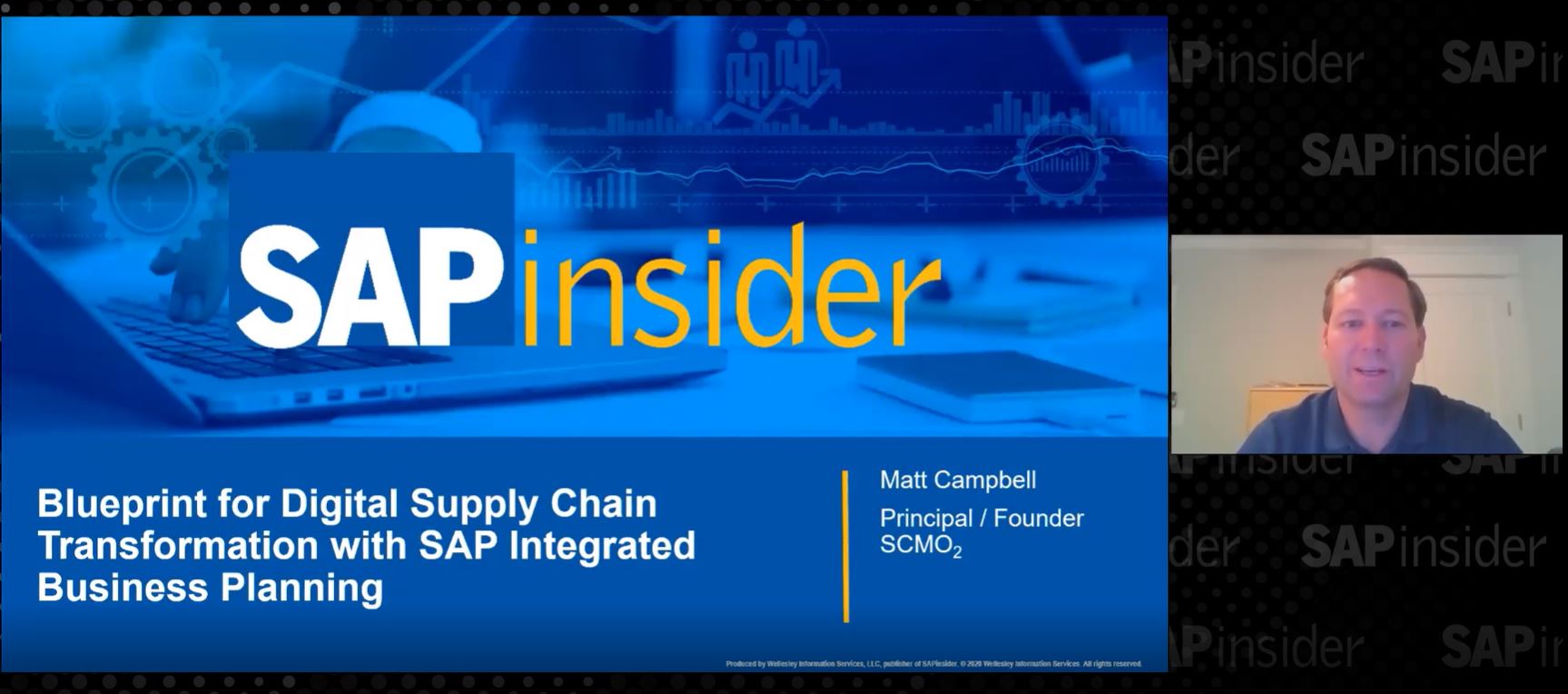How to Build a Resilient and Efficient Supply Chain With Robust Sales and Operations Planning Using SAP IBP S4HANA
By Ulaganathan Balakrishnan, CPIM/CSCP, Tata Consultancy Services
Abstract: Many organizations in their race to embrace technology ignore a key ingredient for the successful implementation of their Sales and Operations Planning: Organizational Readiness. Drawing from our deep experience in implementing Sales and Operations Planning (S&OP) across diverse industries we outline key steps the organization should pursue in the preparatory phase before any system implementation.
What is Sales and Operations Planning?
Sales and Operations Planning (S&OP) is a mid-long-term Planning process to estimate the demand for the organization’s products/services at an aggregate volume level using some form of forecasting method and incorporating inputs from Sales and Marketing teams. The process goes through a monthly process cycle involving Sales, Marketing, Production and Finance teams to fine tune the plan to meet both organizational financial goals and operational constraints to provide an optimistic while still realistic plan. Typically, the horizon reviewed in the process is between 18-24months on a monthly frequency taking roughly 1-2 weeks. The typical use of the S&OP plan is for estimating long term resource and material needs. S&OP when executed with the right processes and controls will enable an organization to respond to customer needs in an efficient way improving the customer service levels which ultimately improves the company’s bottom line. One of the first thing to align is for a common definition within various departments as some call it as long-term planning and budget planning as some of the terms. It may require few meetings to align with the standard definition and goals of this process t begin the journey.
Why an organization need S&OP?
- An integrated S&OP process will provide a single, common, and strategic direction for demand and supply planning.
- Scenario testing allows the optimization of the supply plan to minimize costs and maximize customer service.
- Contributions from a wide variety of stakeholders will ensure that cross-functional and collaborative decisions are made.
- All the above drives the organization to compete in the market with the cost-efficient product/service offering.
Some of the key benefits from the S&OP process includes: Improved forecast accuracy, improved revenue, improved customer service levels, reduced time to market new products and improved supply planning. The main advantages of a formal established S&OP process is that it can be measured and monitored for performance and be able to modify the processes based on the market need. One client was able to introduce a new planning level that made it possible to clearly review a particular sub-family for better forecasting and supply planning. Such insights come through formal S&OP process and review of the monthly results.
Organizational factors impeding the success:
Once an organization senses the need to implement the S&OP process and begins the journey, they are caught mid-way with several roadblocks that jeopardizes their implementation. As a result, the project either fails or implemented without getting the benefits originally desired. The S&OP slowly takes the back seat in the organization and results in slow death. We attempt to high light some of the key challenges we have seen in both successful and lesson’s learned S&OP projects to outline a prescriptive approach for a successful implementation in this article. We call this as the Organization readiness on a maturity assessment framework.
Multiple S&OP teams: Different business units within an organization may have its own S&OP planning processes for different product lines, especially due to M&A activities. Based on the maturity of the acquired business units, they may have some form of long term planning which may be internally called as S&OP. Identifying this early and forming a special interest group(SIG) to align on a common best practice S&OP will ensure the organization speaks the same language and have one S&OP process to address. If this is differed for the implementation phase, there will be time and resources lost to arrive at a common process. An overall S&OP organization structure with multiple S&OP managers for each of the business units will establish the required framework for smoother journey.
Lock of Ownership– Who owns the S&OP is a bigger question in many organizations as the production team may start the monthly meeting and go around with the sales managers to develop an agreed plan. The meeting if not going over the last month’s plan vs actual then the exercise does not include a key component for S&OP success: Ownership and Accountability. Under or over estimation of demand, lack of capacity as promised need to be discussed and a clear action plan need to be established.
Financial Budget driven: S&OP do have to consider the financial goals and impact when developing their plan, however some organizations that do not have a formal S&OP process use the annual financial budget to develop some rough level sales and operations plan. The nature of the budget allows no ability to evaluate the plan as long as the annual budget value matches the annual operation plan. This leads to too much expediting and increased logistics cost when the customer demand differs from the established operation plan which was meant for meeting financial goals. The mitigation for this risk is to involve the financial stakeholders in the educating S&OP best practices and get their buy-in to use annual budget as one of the inputs to the S&OP process while shaping the forecast using market conditions. As the forecasting process is established, this could be integrated into the annual budget planning as the organization matured in its demand shaping ability.
Forecast bias: If the S&OP team does not believe that their product lines could be forecasted, then we are looking at a primitive form of forecasting called Judgmental forecasting, one in which each member just provided input based on his gut feel at a high level. The organization need to identify its competitor’s strengths and industry trends to position itself as the industry leaders. Educating the team in both the industry reality and organization product structure will facilitate to overcome this challenge.
Reality Gap: As the social media and information out there advertises the state-of the art technologies available to support S&OP, the reality of an organization’s ability to adapt them is usually ignored. This is an area where the leadership has to preach the crawl, walk, run mind-set within its executive S&OP team so they are not overwhelmed by the tool’s product features but focus on the organization’s need.
Framework for a successful S&OP practice: Phased approach
Our recommendation for navigating the implementation of a successful Sales and Operations process falls under three phases as depicted in Fig-1. Most projects focus on the ‘IMPLEMENATION’ phase while we emphasize the “PREPARATION” and “SUSTAINING” phases as part of the journey to meet the overall goal of the S&OP implementation. We will address in detail the first of the three phases in this paper. We will explore the other phases in subsequent articles.

Preparation Phase:
We see a need for two sub-phases under the preparation: Organization readiness and Business Assessment. They are both sequential stages that should not be ignored in the S&OP journey.
Organization readiness:
- Business strategies typically drive the S&OP process in successful organizations and communicating them and establishing business priorities is the first step for beginning the S&OP journey. Some of the questions to consider are:
- Is the organization driven to meet the financial goals? Budget drives production not sales demand in few markets making it more off-the shelf sale with less variety.
- Are there too many new products that need to come to market annually? Reducing the time to introduce new products in the market
- Is there too many external partners need to be included in the process? Contract manufacturing driven organizations need to involve the vendors in their S&OP process to develop feasible plans.
- Is there a need to venture into new markets? Selling to new customer base/region to take into account the ability to expand/realign production and logistics capacities as part of the S&OP process.
- Recognize the need for the centralized S&OP process: Many organizations have some form of long-term forecasting and rough capacity planning based on budget provided. These are based on individual knowledge of corporate and plant personal using their own spreadsheets and data. As a second step, the need to centralize this less formal process has to be recognized and clearly communicated from the top-down. A well communicated strategic initiative sends the signal that the organization is looking to revitalize its business processes and synergize the efforts of its assets. A sample S&OP organization structure below depicts how this could be achieved by aligning the teams across Sales and Operations departments.

- Formalize the team and define the roles clearly: This will call for defining or modifying the organization structures to enable ownership is assigned to both Customer facing managers and operational plant managers. We propose they both report to the same higher leadership so there is synergy in their efforts to drive the same goal established as part of the business strategy mention in (1) above. Typical roles amongst the teams that is involved in the S&OP process is defined below:

- As the above roles are defined, special attention needs to be given to align the annual rewards to the performance metrics that has long term positive impact on the process. We have seen that the goals of the operations managers are tied to dollar value of inventory levels without focus on the product mix needed. Operation efficiency takes a front seat in execution though the organization may want to be lean and agile to meet changing customer demand. This creates a disconnect as we mentioned earlier on the business strategy and the rewards need to be tied to achieving the higher business goals not just operational efficiency as in this example. Another manifestation of the issue is higher logistics cost due to unrealistic order promise dates and over estimation of production capacity.
Business Assessment:
- The business assessment part of this phase calls for designing supply chain questionnaires and surveys from the stake holders of the S&OP processes to identify the current practices and cultural challenges that may lie ahead. These surveys can be designed in various forms but the focus should be the current practices and pain points.
- An external consulting team may be engaged to conduct workshops beyond the surveys or instead of surveys, if the organizational culture is a challenge to collect such information. The consultants have several tools to conduct one-to-one or workshop style sessions for groups to bring out the current business procedures and pain points. The advantage of hiring an external consultant in this phase is that it can be time driven, focused and results delivered for future action.
The preparation phase typically takes 3-6 months depending on the organization size and the level of complexity in its business structure. The initial business readiness sub-phase should be an organic need stemming from the business need to become a differentiator in its industry. Once the outcome of the business readiness is in place, the team can begin their business assessment stage involving the newly formed team. The support needed for this preparation phase can be acquired from external consultants who have implemented a process driven S&OP process and not a tool configurator.

Conclusion:
Sales and operations planning is a business strategy oriented, process driven, collaborative process that requires both internal cross-functional teams and external partners to develop a tactical mid-long term sales and production plans that is optimal and feasible.
Bringing multiple groups under a single executive team structure, establishing the ownership clearly, setting clear guidelines on the use of annual budget, helping its team realize the reality gap of the organization and thus preparing the organization for the journey are all part of the readiness effort an organization should take in the right direction.
The success of the end results depends largely on how the organization prepares itself for the journey by educating, motivating, and organizing the teams and defining the goals clearly to all its stakeholders.





